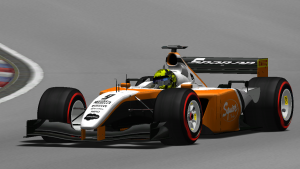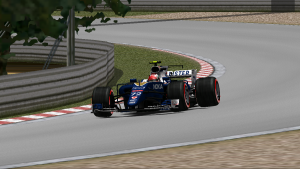Announced during the 2015 silly season period, Pedersen driver Nico Rosberg will be retiring from FF1M at the end of the 2016 season to explore new career ventures, and it looks set to be a rather subdued departure having had his final attempt at winning another championship fade thanks to his car being outdeveloped by other teams.
Rosberg had a highly successful junior career which began at the 2003 British FF3M championship where three wins took him to 3rd in the championship, tied with Robert Kubica but behind on countback due to the Pole winning double the amount of races. Rosberg would exact revenge in the following season and beat Kubica to the championship by just seven points. Two seasons of FF2M followed where Rosberg finished in the top five twice, including two wins at Silverstone and Spa during the Europe season.
At this point, Rosberg was also Gui Racing’s test driver, and team boss Gui Cramer was sufficiently impressed that he gave Rosberg an early FF1M chance in the place of Felipe Massa for the final three races of the 2005 season. Although his debut at Shanghai wasn’t sparkling, qualifying 4th on the grid at Suzuka was an indication of the talent Rosberg had, and at Interlagos, he scored his first career points with 6th.
With Gui Racing favouring a different German to partner their current German Timo Glock, Rosberg moved to FJR for 2006 alongside Heikki Kovalainen in what was an inexperienced line-up with just 20 FF1M races between them. Furthermore, FJR were in a state of rebuilding after unsuccessful defences of both championships in 2005. After a fairly steady first three races which included a maiden podium finish at Sepang, FJR found a lot of development in the first mid-season test and as a result, Rosberg dominated at Imola for his first career pole and win. He followed this up with a more hard-fought win at the very next race at the Nurburgring and became a serious championship contender.
Three more wins at Monaco, Monza, and Suzuka followed despite silly driver errors in all three races, of which the latter two occurred on the final lap. Going into the final race, Rosberg led the drivers championship by 12 points from Shannon’s Vitantonio Liuzzi. The only way Rosberg could lose the championship was if he didn’t score and Liuzzi won, as the Italian still had a chance on countback. However, FJR had an ace up their sleeve. A lack of results led to Kovalainen being replaced by test driver, Vitaly Petrov, but then he was replaced with four rounds remaining by Michael Schumacher, who had unexpectedly become a free agent mid-season after being sacked by Gui Racing. In his final ever FF1M race at Interlagos, Michael was untouchable, and his victory helped to secure the drivers championship for Rosberg in his first full season.
Unsurprisingly, Rosberg remained with FJR for 2007 and got off to a flying start with victory at Melbourne. Unfortunately, that was as good as it got for the German as FJR struggled for consistency throughout the season and couldn’t keep up with the likes of Sebastian Vettel and Lewis Hamilton. Rosberg managed four more podium finishes at Monaco, Montreal, Silverstone, and Suzuka, but it could’ve been more after reliability problems at Sepang, Hockenheim, and Spa. After winning the championship in the previous season, 5th was disappointing.
Things got even worse for Rosberg in 2008. The first race of the season at Melbourne was an embarrassingly anonymous affair after FJR apparently forgot to set the power output from their new self-built turbo engine. He was on for a certain podium finish at Sepang before suffering an engine failure with four laps remaining, and then after losing another engine whilst running 2nd at Valencia, his confidence completely went and his relationship with FJR soured. Two unnecessary collisions at the Nurburgring and Montreal plus qualifying last at Silverstone led to his sacking mid-season having scored no points compared to Fernando Alonso’s 40, a monumental downfall from his championship winning season. Luckily for Nico, he was quickly snapped up by Dark Wolf and with a point to prove, he was back on the podium in just his second race with the team.
Although rejuvenated by his team switch, 2009 got off to a dreadful start for Rosberg after failing to qualify for the first two races. A switch from medium to soft tyres helped out and at Jerez, Rosberg took the first of five pole positions before failing to qualify in the very next race at Monaco. His other pole positions came at Montreal, Singapore, Sonoma, and Interlagos. He could’ve won at Singapore, but had to settle for 3rd after his soft tyres faded dramatically towards the end of the race. Another podium finish at Interlagos left Rosberg 10th in the drivers championship in a season where nearly every team suffered from poor reliability.
2010 saw Rosberg reunite with his very first FF1M team, Gui Racing, alongside old FF3M rival Kubica. It was another peculiar season where reliability played a significant role with most teams suffering. Although Rosberg had a relatively decent finishing record compared to much of the field, his car wasn’t particularly competitive and he didn’t score a single podium finish all season. He matched Kubica’s 26 points tally, but the Pole’s 2nd place at Interlagos gave him the edge on countback, even if it was only for 13th in the drivers championship.
Rosberg was on the move once again as his Brazilian team favoured an all Brazilian line-up, so Nico went on to form an all German line-up with 2007 champion Vettel at Shake ‘n’ Bake, who had won the previous two drivers championships and also the 2009 teams championship. Despite a poor opening race at Melbourne where he spun off on the second lap, Rosberg bounced back brilliantly by winning the following two races at Sepang and Sakhir. Two more podium finishes at the Nurburgring and the Red Bull Ring followed, and with the help of teammate Vettel, Shake ‘n’ Bake were able to challenge for the teams championship. However, a dreadful final three races without any points meant that they lost out to both Tornado and a resurgent Pedersen. As for the drivers championship, Rosberg finished 6th with 52 points, just two behind Vettel.
It was back to Gui Racing for Rosberg in 2012 after just one season with Shake ‘n’ Bake, although the Brazilian team had changed their name to Sean Connery Motorschhh. With works Ferrari engines at his disposal, Rosberg set his sights on once again challenging for his second championship. He had a brilliant first four races with podiums in all including two wins at Interlagos and Imola. An 18 point lead in the drivers championship quickly disappeared three races later however after a bad run of reliability and a careless crash from the lead at Monaco. Ultimately, SCM couldn’t keep up with Tornado’s aerodynamic development and Rosberg would eventually finish 3rd in the drivers championship despite another win at Spa. He did however set a record for most pole positions in a single season with 12, a record that has yet to be beaten.
Frustrated by the lack of a second championship, Rosberg jumped ship from the established teams of old to relative newcomers, Willows Racing, who’d had a strong 2012 season (Their debut in the mainstream format). Unfortunately, the team’s Mercedes engine had been outdeveloped by Ferrari and later during the season, Renault. The best Rosberg and Willows could manage all season was a 3rd at a damp Shanghai after choosing the right tyres at the start. A handful of other points finishes left him a disappointing 11th in the championship.
Nevertheless, Rosberg remained with Willows for 2014 in the promise of a much better car and the potential of new engine regulations threatening to shake up the running order. He was also reunited with 2008 teammate Alonso and had a point to prove to his Spanish teammate after his demoralising 2008 season. The Willows-Ilmor package was immediately competitive from the opening race and like 2012, Rosberg took four podium finishes in the opening four races including one win at Sepang and led the championship. But also like 2012, Rosberg failed to finish the following three races, two of which he crashed out of from very promising positions.
Willows remained competitive throughout the season and Rosberg took four more podium finishes at Road America, Silverstone, Spielberg, and Singapore, although at Singapore, he was rather lucky as he and Alonso collided in the closing stages. In amongst the podiums however, the errors remained, such as at Hockenheim where he pushed his chase of 3rd place too far and crashed out. Although both Rosberg and Alonso couldn’t challenge Vettel and Hamilton for the title, their dependable partnership helped Willows to their first and so far only teams championship.
With Alonso moving to Tornado for 2015, Rosberg assumed the role of team leader and mentor to Belgian rookie, Stoffel Vandoorne. Towards the end of 2014, Willows had lost a bit of their edge, and it was clear from the opening race of 2015 that they had slipped further down the order. There was also an embarrassing moment for Rosberg at Interlagos where he was forced to queue behind his teammate during a pitstop. Willows then adopted an aggressive ERS strategy for the remainder of the season with mixed results. Rosberg scored podiums at his two home races and also at Monza, although his win at Hockenheim was controversial as he once again collided with Alonso (This was unseen by cameras but rather described by the AFIA). He also lost at least four more podiums at Estoril, Montreal, Road America, and Spa due to unreliability. This prompted him to announce during the silly season that 2016 would be his final season in FF1M.
For that final season, Rosberg returned to an established name in the form of Pedersen. The timing seemed to be perfect as the Danish team had switched back to Mugen engines which have proven to be very powerful and reliable. Having dominated the final day of pre-season testing, Rosberg won the opening race at Melbourne having started from pole position by a mesmerising seven tenths of a second, although he did have to see off a challenge from Cooper Lee. At Interlagos, the qualifying gap grew to nearly nine tenths, but his suspected qualifying biased set-up meant that he slipped to 5th in the race. Another podium at the Nurburgring followed, but as had been the case for many seasons before this one, Rosberg just couldn’t sustain a championship challenge. It took him another eight races before he returned to the podium at the Hungaroring despite an early mechanical issue compromising his strategy, and then he took a fine 2nd at Hockenheim, but three non-scores immediately after that have ended any hopes of winning the championship in his final season.
After his brilliant championship win in his first full season, some could say that Rosberg has underachieved having failed to win a second. He would often start a season strongly before fading towards the end for one reason or another, this latest season being the latest example. He also gained a reputation as a qualifying expert with the most poles in a single season, and also breaking the record for most poles of all time at the 2016 United States Grand Prix, although Alonso later matched that at the 2016 Portuguese Grand Prix. Although he would’ve liked to have been a multiple champion with the talent he had, he is still part of an exclusive club of just 14 FF1M drivers who have won a championship. Considering that over 170 drivers have raced in FF1M, that is quite an achievement.






More Stories
2018 Preview : Tornado Motorsport
2018 Preview : Shake ‘n’ Bake Motorsport
2018 Preview : FJR